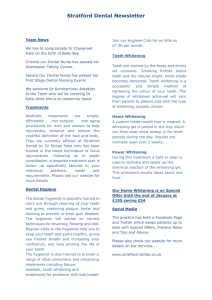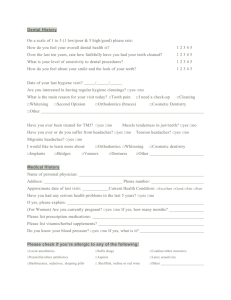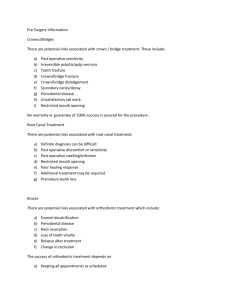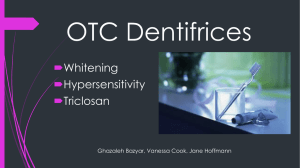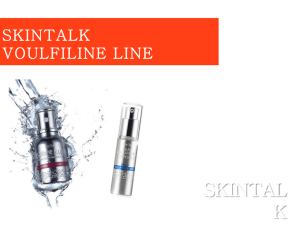TEETH WHITENING USING THE WHITENING STRIPS METHOD VS
advertisement
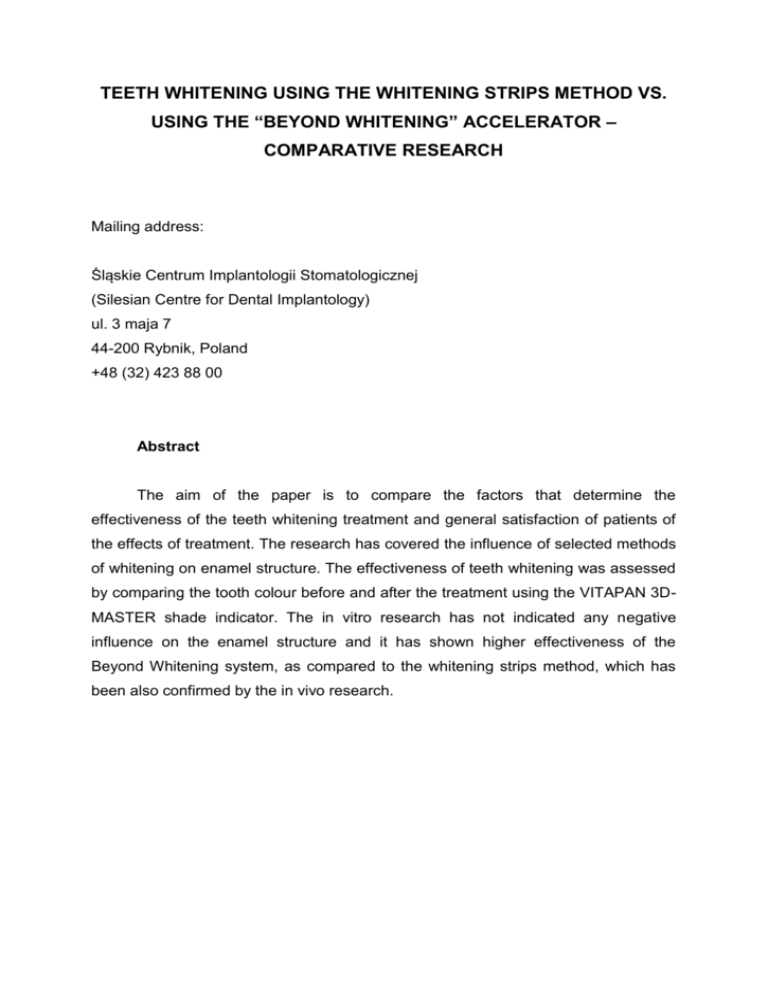
TEETH WHITENING USING THE WHITENING STRIPS METHOD VS. USING THE “BEYOND WHITENING” ACCELERATOR – COMPARATIVE RESEARCH Mailing address: Śląskie Centrum Implantologii Stomatologicznej (Silesian Centre for Dental Implantology) ul. 3 maja 7 44-200 Rybnik, Poland +48 (32) 423 88 00 Abstract The aim of the paper is to compare the factors that determine the effectiveness of the teeth whitening treatment and general satisfaction of patients of the effects of treatment. The research has covered the influence of selected methods of whitening on enamel structure. The effectiveness of teeth whitening was assessed by comparing the tooth colour before and after the treatment using the VITAPAN 3DMASTER shade indicator. The in vitro research has not indicated any negative influence on the enamel structure and it has shown higher effectiveness of the Beyond Whitening system, as compared to the whitening strips method, which has been also confirmed by the in vivo research. Introduction Among all the procedures used in oral health care, teeth whitening is one of the methods that give patients the greatest satisfaction. It is essentially a beautifying treatment, but considering the boost that it gives to state of mind and self-esteem, it also has a substantial therapeutic effect. This treatment usually involves solutions containing hydrogen peroxide and urea peroxide. Effectiveness of compounds containing H2O2 has been confirmed by numerous researches (1,2). However, there is a certain controversy over safety of using hydrogen peroxide, while the mechanism of its whitening effect is not fully understood yet. After long-term use of whitening substances applied on whitening strips (over-night whitening, whitening strips method), there is a frequent effect of tooth hypersensitivity, which is observed in the case of from 10% to 65% of all patients (according to our own research). There are several factors that determine the level of tooth hypersensitivity and they include concentration, time and frequency of application (2) and the state of enamel. Hypersensitivity typically passes after the end of the treatment, but it some cases it persists much longer. In the last years, there have been tendencies to shorten the time of the whitening treatment itself. One of the suggestions is whitening using an accelerating lamp that emits blue light, filtered by about 12,000 optical fibres in order to eliminate the emission of heat and ultraviolet light. The treatment, which takes about 40 minutes, involves emitting light of the wavelength between 480 and 520 nanometres, which activates the substance, spread on the teeth, containing H2O2 and silicon dioxide with an activator and substances that reduce tooth hypersensitivity. This paper focuses on an attempt to compare the influence of whitening using the “Beyond Whitening” accelerator and the whitening strips method on changes in enamel topography. The second part of the paper discusses also subjective opinions of patients after using both methods. Research Materials & Methodology The material used for in vitro research was 10 human teeth (8 incisors and 2 canine teeth), with no visible dental caries symptoms. Teeth had been extracted from nonsmoking and generally healthy patients aged between 30 and 40. Soft tissue was removed from tooth roots and the teeth were cleaned with 9% solution of NaCl and dried. The teeth were mounted in impression material, covered with whitening substance and irradiated with accelerating lamp in three cycles, each cycle being 10 minutes (Picture 1.A,B). After the end of whitening treatment, two teeth were additionally covered with a layer of Fluor Protector varnish. In the second case, the mounted teeth were whitened using a whitening tray. POLA gel manufactured by SDI, with 16% hydrogen peroxide concentration, was applied. In the laboratory, a tray was produced and covered with a thin layer of POLA NIGHT gel. Whitening was performed in 14 day cycles, each cycle lasting about 6 hours. For this time, the prepared sample was placed in solution of salt in temperature of 5C. After removing the tray, teeth were wiped and rinsed with water. In order to examine the structure of enamel, the teeth were dusted with a thin layer of gold and analysed using second level scanning electron microscope (SEM). The research was carried out in the Faculty of Material Science of the Silesian University of Technology, using a Hitachi S-4200 microscope. Microscope images were analysed in a magnification range of 100 x to 10000 x. In the second stage (clinical trials), teeth whitening was evaluated using a VITAPAN 3D-MASTER shade indicator. Results & Discussion As a result of the first stage of the research, microphotographs of enamel morphology were obtained. After whitening treatment using the “Beyond Whitening” accelerator, in magnification of x1000 and lower, thin white lines on the enamel (Picture 1.A,B,C) were observed. In magnification of x2500 and higher, one can notice that characteristic lines come from spot secretions that fill some interprismatic substance (Picture 2.A,B,C). Arrangement of secretions (characteristic strips) is perhaps the effect of the method of whitening substance application (spread with a paintbrush). Due to small percent concentration of the secreted phase, the attempt to measure its chemical composition was not successful. Examination of the two samples showed also macrocracks (Picture 1.A,B), which appeared probably during the preparation of samples. The secretions are less visible on the two samples that were varnished after the whitening treatment, but the layer of varnish, in the shape of streaks, is clearly exposed. No visible defects of hard tissue of the teeth that would be caused by application of the substance were noticed in any of the whitened and examined samples. Teeth were whitened on average by 8 shades according to the Vita scale. In the second case (samples whitened using the whitening strips method), the examined structured are not significantly different from the previous structures. Sample microphotographs are presented in the Picture 4. The only visible difference can be the fact that in magnification of x5000 and higher, the interprismatic surfaces are more visible. It is probably caused by individual features and has no significance for comparison of the two methods. Second stage of research, clinical trials Subjective Whitening Whitening level in the method Vita 3d scale 1 BW 3M2 1M1 5 3 2 BW 4R2,5 2M3 5 8 3 BW 5M3 3M2 5 1 4 BW 3M2 1M2 5 4 5 BW 4M2 2R2,5 5 1 6 BW 2M2 1M2 5 7 7 BW 3M3 1M2 5 6 8 BW 4L2,5 2L2,5 5 6 9 BW 3M2 1M2 5 8 10 BW 5M2 3M2 5 6 11 BW 4L1,5 3L2,5 4 8 12 WS 4L2,5 3M3 3 3 13 WS 3M2 2M2 4 1 14 WS 4M2 2M2 5 4 15 WS 3M3 2R2,5 2 7 16 WS 3R2,5 2M3 4 3 17 WS 2M2 4M2 0 10 18 WS 3R1,5 2R1,5 4 4 19 WS 3M2 2M2 5 1 20 WS 4M2 2M2 4 9 No. opinion of the Hypersensitivity level patient According to the patients, teeth whitening using the Beyond Whitening system is not inconvenient or oppressive. Subjective opinions expressed in the performed survey indicate that patients are really satisfied with the treatment. The most frequently reported problem after the treatment was tooth hypersensitivity. Some patients reported annoying burning of the vestibular surface during the treatment. In the case of the whitening strips method, hypersensitivity occurred on the second or the third day after application of the whitening substance. Patients most frequently reported the sensation of tingling, burning, reaction to cold, heat and touch. Moreover, in several cases, patients reported joint pain caused by increasing the height of occlusion and some of them complained about salivation. Due to discomfort, some of the patients did not follow the instructions on the time of the substance application per each day. Our experience has shown that the patients who had the whitening treatment using the whitening strips method did not achieve a satisfactory whitening effect even if they had precisely followed the instructions. The possible reason could be eating between the whitening cycles. Such effects do not occur in the case of whitening using the Beyond Whitening accelerator, even if a patient smokes cigarettes. Conclusions The research that has been performed enables the formulation of the following conclusions: -Shortening the time of whitening does not have negative impact of the effectiveness of the treatment. -With our today’s knowledge, we can believe that short-term application of 35% solution of H2O2 in clinical environment and longer application of 16% solution of H2O2 at home does not do any serious harm to enamel, which enables an assumption that these methods are safe. -Following the procedures recommended by manufacturers of whitening substances, similar whitening effects were obtained in vitro in the case of both methods., In vivo the method of blue light whitening seems to be more effective, which is proven by whiter shade of teeth. -The differences observed by patients are usually triggered by the discomfort during the whitening strips treatment. Generally, it can be concluded that patients are more satisfied with whitening using the Beyond Whitening method. -Tooth hypersensitivity which occurred in both cases is a common effect. However, after using the Beyond Whitening accelerator, it is often necessary to give patients analgesic medicines on the first day after the treatment. Literature 1. L Ilewicz, W Świdziński, M Skucha-Nowak, S Renk „Obraz szkliwa poddanego wybielającemu działaniu preparatów na bazie nadtlenku mocznika w skaningowym mikroskopie elektronowym” Annales Academiae Medicae Silesiensis 2002 supl.46 154-160 2.Haywood VB History, safety, and effectiveness of current bleaching techniques and applications of the nightguard vital bleaching technique. Quintessence Int. 1992;23 471- 488 3.Leonard R., Sharma.,Heywood V.: Use of different concentration of carbamide peroxide for bleaching teeth and in vitro study. Quintessence Int. 1998; 29: 503-7. 4.Nathoo S. and others: KINETICS OF CARBAMIDE PEROXIDE DEGRADATION IN BLEACHING TRAYS. j Dent REs 1996; 75: 286. 5. Barlett D.: Bleaching discoloured teeth. Dent Update 2001; 28: 14-8 6.Mazur-Koczorowska A.: Przegląd metod wybielania zębów – wady i zalety. Pozn. Stomat. 2002; 127-33. 7.Smigel I.: The truth about whitening. Report a Supersmile, New York, USA 2001.
